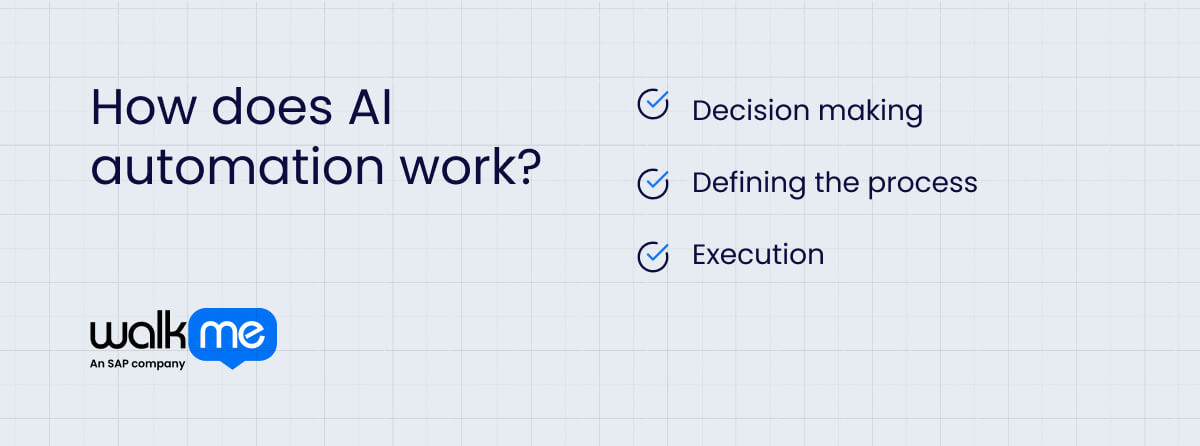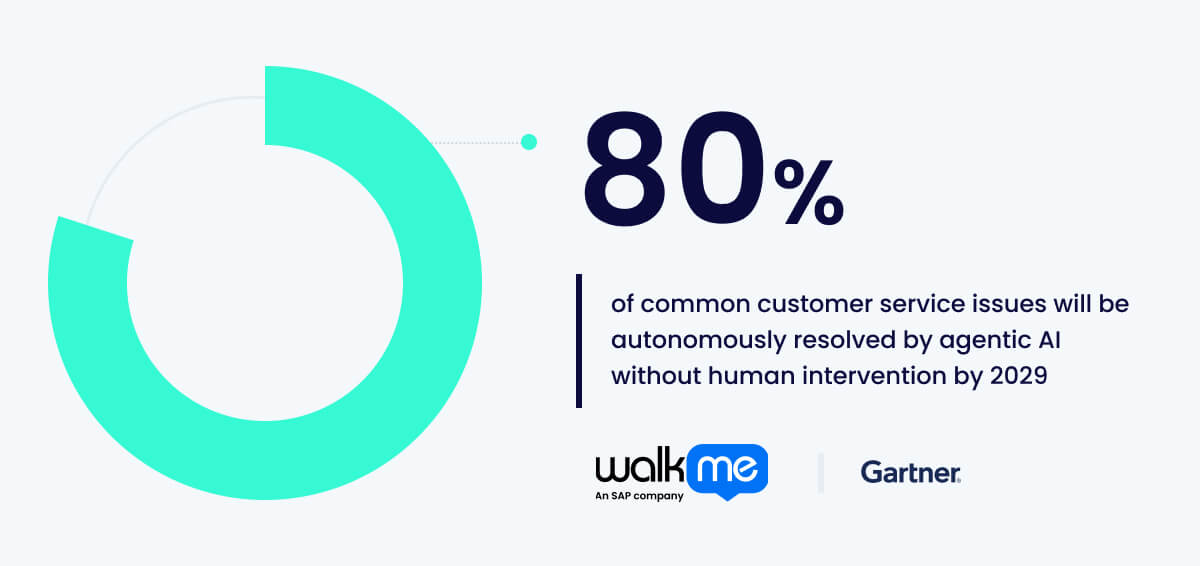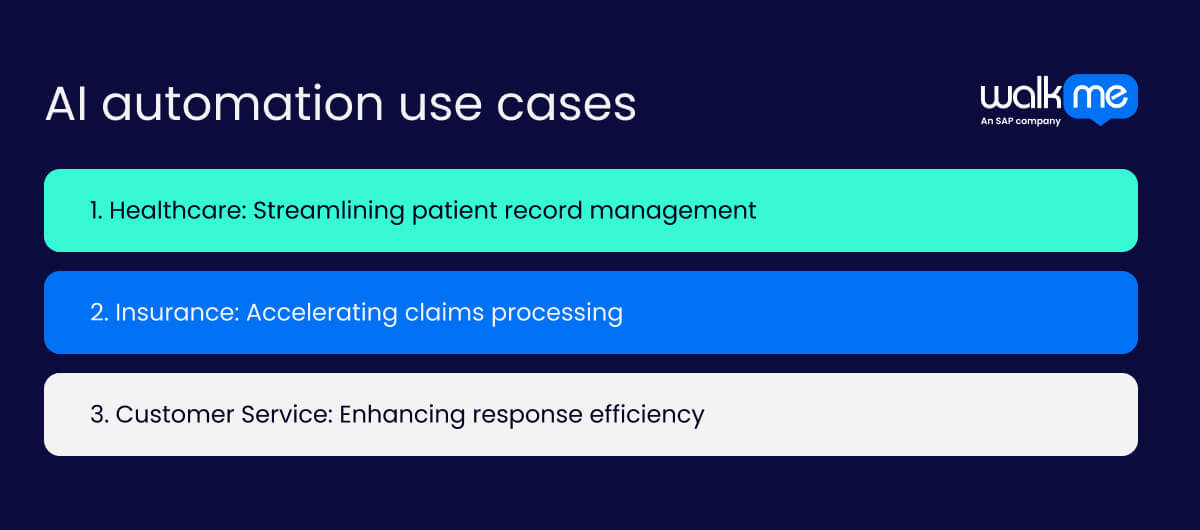What is AI automation?
AI automation refers to the use of artificial intelligence to perform tasks that would typically require human involvement.

Unlike traditional automation, which follows fixed rules, AI automation can improve its behavior based on what it learns. It could update its responses after seeing more data or adjust actions when new input appears.
Various technologies are deployed to enable AI automation. Machine learning platforms help computers learn patterns from data, while natural language processing allows systems to understand and respond to human language.
Robotic process automation (RPA) software can carry out simple, repetitive tasks like entering data or moving files, and when combined with AI, it becomes more flexible and capable.
AI automation can be used in software alone or in conjunction with hardware, such as sensors or smart devices that collect data and respond to their environment.
Why is AI automation important?
Implementing AI automation allows businesses to outsource low-level tasks to artificial intelligence, freeing up human resources for more strategic thinking and creation.
As the system improves its performance with use, it will continue to streamline business operations over time, taking on more responsibility and responding more intelligently.
What’s more, AI automation is no longer a distant concept. Instead, it’s a growing force behind fundamental business transformation. According to the latest McKinsey Global Survey, more than three-quarters of businesses are already using AI in at least one function, with adoption accelerating rapidly across both analytical and generative AI.
Larger companies, especially those with annual revenues exceeding $500 million, are leading the way by redesigning workflows, appointing AI governance leaders, and retraining employees to participate in the deployment.
When AI automation is rolled out across multiple business processes, it evolves into hyperautomation, which enables even more impactful digital transformation.
How does AI automation work?

AI automation combines several technologies that enable systems to automate tasks and make decisions with minimal human input. What’s more, the capability is rapidly improving. Gartner predicts that agentic AI will be able to autonomously resolve 80% of common customer service issues without human intervention by 2029.

These technologies don’t operate in isolation. Instead, AI, BPM, and RPM build on one another to form the foundation of automated systems that can operate at scale.
Let’s take a closer look at the steps which are involved in AI automation:
Decision making
At the heart of AI automation is the decision-making layer. Artificial intelligence helps systems to interpret data and spot patterns. It uses this information to decide on what to do next.
Machine learning models come into play here, learning from past outcomes and improving the system’s responses over time. However, some scenarios can be more complex, in which case neural networks will become involved. These will layer data to handle larger processes, such as recognizing speech or sorting through documents.
Underpinning all of this activity are algorithms that guide the system’s actions and instruct it on how to respond in various situations. AI can make sense of the input, whether it’s a structured spreadsheet or a complex email chain, and determine the next step.
Defining the process
Making decisions is only part of the story. They have to lead to action, which means BPM gets involved. Its role is to ensure the tasks move through a process.
Business process management systems will define the flow of work, which often connects people, tools, and rules. Next, they ensure that a decision reaches the right person.
For example, if a process involves simply approving a refund, it can be automated without human involvement. However, escalating a support ticket may involve passing it on to an inbox monitored by humans with a rule assigned for the timeline within which they must respond.
BPM is further enhanced by adapting to changing priorities in real time. They might redirect tasks or flag when there are delays to ensure nothing gets lost.
Execution
Once the process has been defined, it’s time to execute it. Robotic process automation brings in software bots to take over any tasks that require simple and rule-based steps. For example, filling out forms, moving data between systems, or sending routine emails.
When RPA bots operate independently, they are rigid in nature and only perform tasks as instructed. However, when combined with AI, RPA gains a new level of flexibility. So, if an AI model detects a billing error, it will instruct a bot to issue a credit, even if it wasn’t part of the original script.
AI automation use cases

Understanding how AI automation is applied in real-world settings highlights its potential to streamline tasks, boost accuracy, and free up time across industries. When deployed effectively, it enhances both operational efficiency and responsiveness to human needs.
Healthcare: Streamlining patient record management
Managing digital patient records is a time-consuming task in healthcare, but AI automation makes it significantly more efficient. These tools can scan large volumes of clinical notes to extract key information, such as prescribed medications or test results, automatically.
AI can also detect missing entries or inconsistencies within electronic health systems. This reduces manual data entry and allows healthcare staff to focus on higher-level responsibilities, while automation handles the routine documentation workload.
Insurance: Accelerating claims processing
In the insurance sector, AI automation is transforming how claims are processed. When a report is submitted, AI can read and analyze documents, cross-referencing them with internal policies to expedite approvals or flag inconsistencies.
By automatically identifying errors or unusual details, the system can escalate those cases for human review. This allows claims teams to spend more time on complex evaluations while ensuring that repetitive tasks are handled quickly and accurately.
Customer Service: Enhancing response efficiency
Customer service teams deal with a constant influx of messages, from emails to live chats and web forms. AI automation helps manage this flow by filtering, labeling, and interpreting input data using advanced language models that understand user intent.
Once processed, the system routes each request to the appropriate department or support tier. As a result, representatives can dedicate more time to resolving complex issues, while routine inquiries are handled automatically and efficiently.